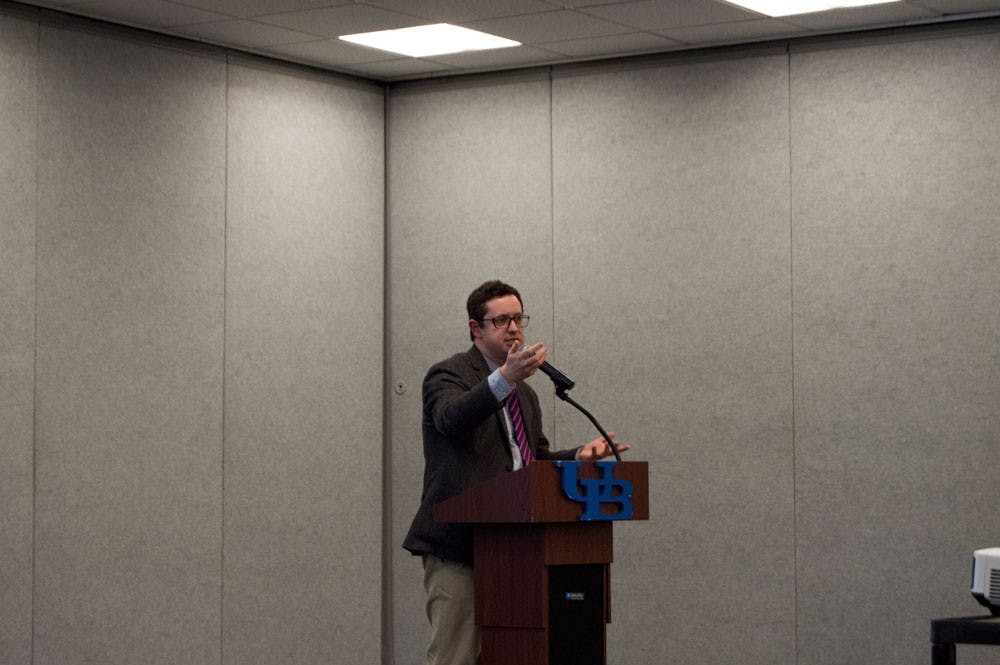Philip Glick, chair of the Faculty Senate, cited the teamwork and patience maintained by all involved in the brand new UB Curriculum program as a fantastic example of shared governance.
In its first meeting of the spring semester on Tuesday, the Faculty Senate discussed the new general education curriculum that was passed by the body in December of 2014 and is set to begin next fall with the incoming class of 2016. The curriculum is now being organized into a cohesive structure and classroom schedules are already being scheduled in accordance to the program.
“We are on a fantastic track right now,” said Andrew Stott, vice provost and dean of undergraduate education. “This may be the largest overhaul of the undergraduate program in over 20 years, if not more.”
Up to 1000 courses have been revised, newly proposed, or somehow altered to better the program. Stott said the faculty’s participation in such an overhaul was “revolutionary.”
The UB Curriculum is made up of four components: the UB Seminar, Foundations, Pathways and a Capstone project, each to be completed seamlessly throughout an undergraduate student’s time at UB.
The curriculum will also allow for UB’s new pathfinder tool – a website that will work alongside the hUB to help students plan. The website allows students to see where they are curriculum-wise and what else they need to do in order to graduate.
A major addition to the new gen ed program is the UB Seminar.
The UB Seminar is three-credit course that will encompass a “big idea” topic based on a student’s major and asks questions in critical thinking and ethical reasoning. It is the first component of the new curriculum.
Foundations – the second section of the new curriculum – bundles courses in writing, science, math and diversity. The diversity requirement under Foundations allows UB to be the first SUNY school to require a diversity course for students to graduate.
The Pathways requirement is split into two parts, which are both to be completed upon graduation then narrowed down by one topic in each. They encompass five “UB areas”: arts, civilization and history, humanities, languages and social sciences, according to Stott.
“They are two sets of three courses that are connected by theme and span all disciplines,” Stott said.
Upon entering UB, students will be asked to submit all of their assignments and papers via ePortfolio and eventually must complete a capstone ePortfolio project. Stott said the students will not have to cover the costs of the software.
“We want to get rid of the laundry list version of general education,” Stott said. “We want to layer students’ thinking and to integrate everything to serve a narrative of students’ learning, we’ll reflect that through the Capstone.”
As of Feb. 2, 140 new UB seminars have been approved and 6,100 students have enrolled in the ePortfolio pilot for the next school year. The student count was up 300 people since last winter with 75 percent of classes offered online.
“There was a rich array of students encompassing 10 programs and nine countries,” said Provost Charles Zukoski.
Zukoski also said the dean searches for the School of Dental Medicine, the School of Management and the College of Arts and Sciences will be completed by the beginning of the fall 2016 semester.
Another major topic of concern for the senate from last semester was teachers selling their own textbooks to their students as the required class textbook and some accepting cash for the books in the classroom. Glick said there were both positives and negatives involved in the process of fixing this problem.
“Teachers involved had questions because they believed they were saving students money,” Glick said.
The senate passed a textbook resolution that regulates the process last semester and it is now in full effect.
Evan Schneider is the assistant news editor and can be reached at evan.schnieder@ubspectrum.com.





